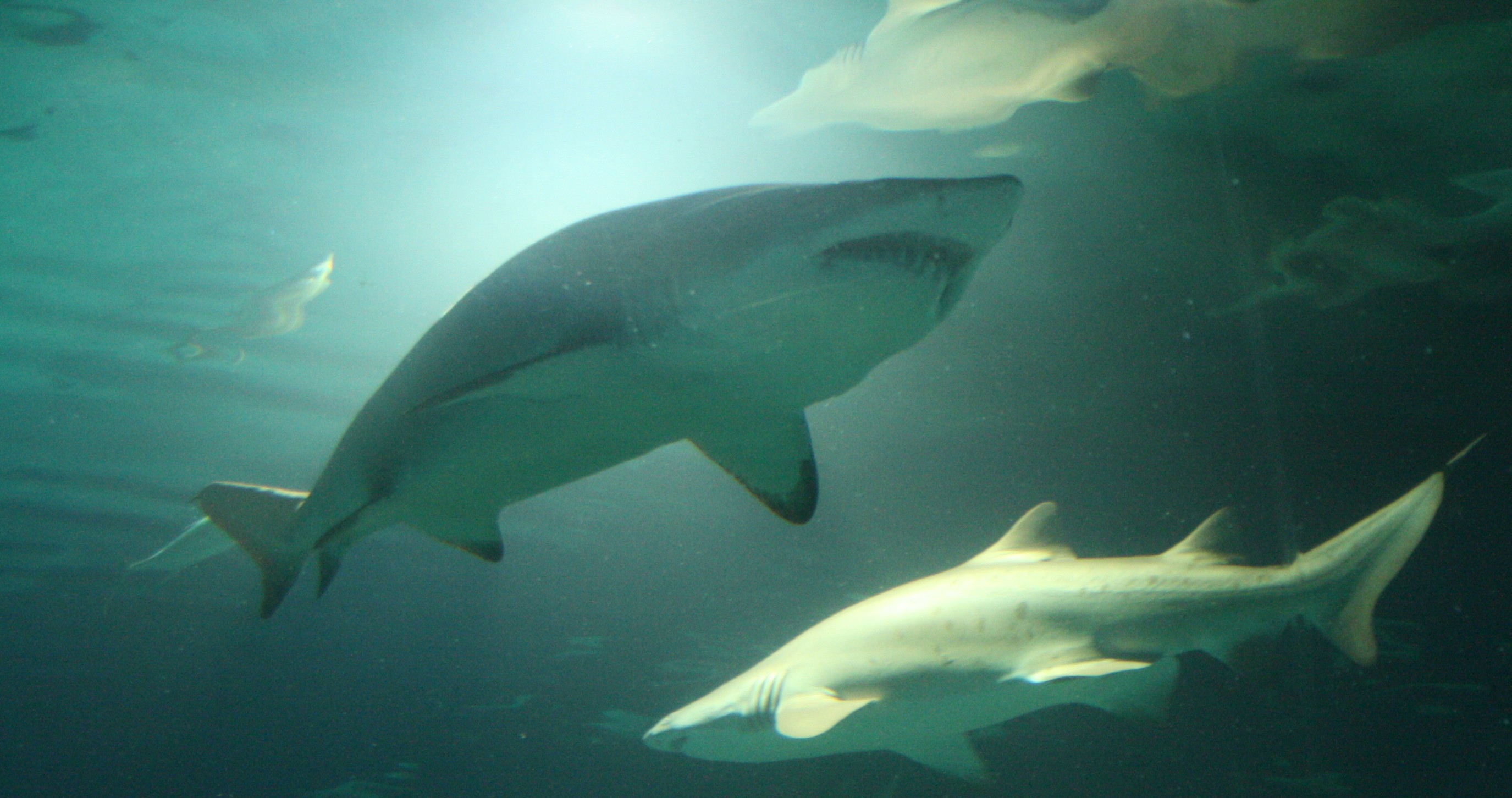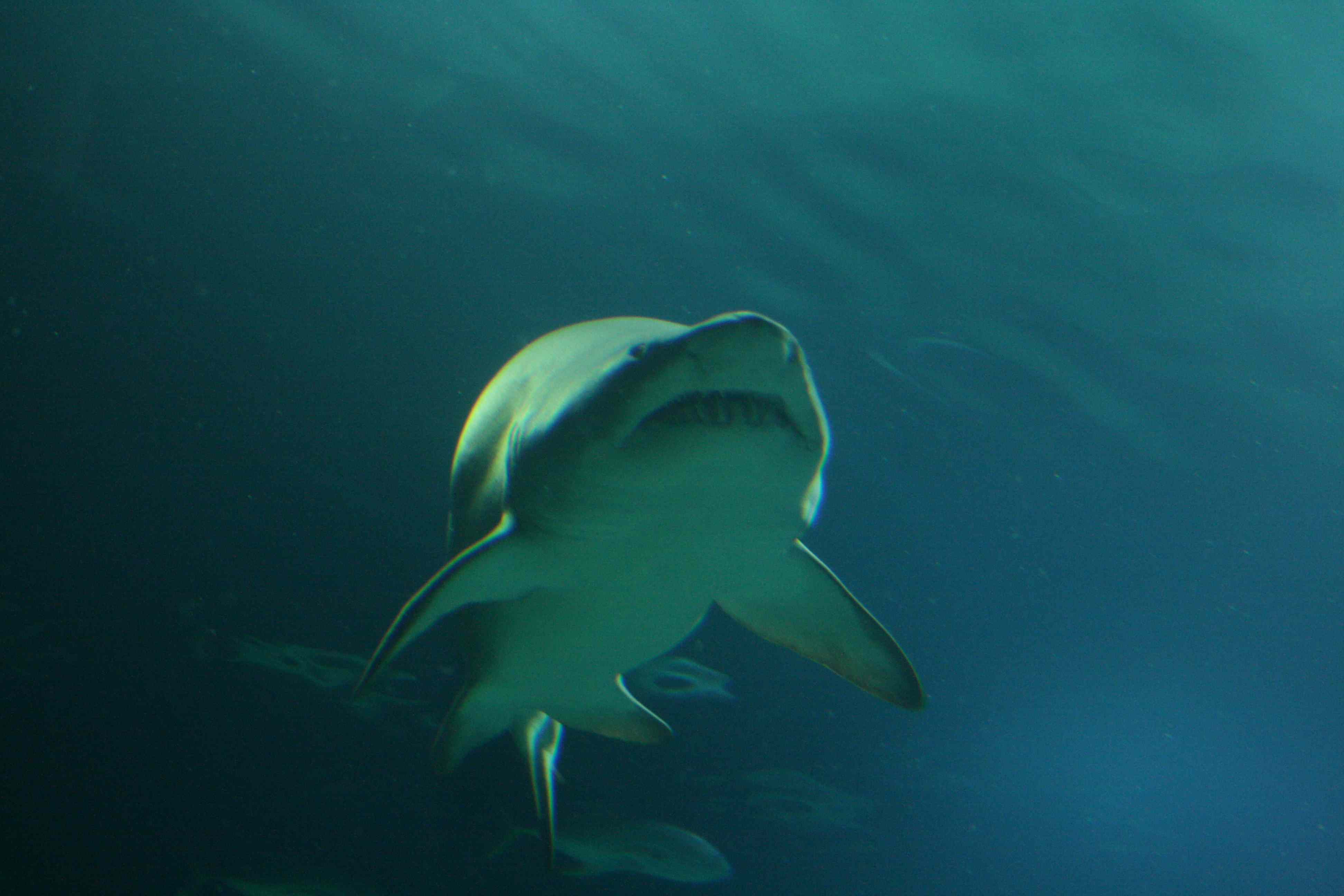Near 40 Biological Sciences professionals, specialists in different aspects of the biology of sharks and other fish, expressed their concern about irresponsible and illegal attitudes like those shown in a recently released video, in which recreational fishermen exhibit a catch of 8 specimens of “Escalandrún” (sand tiger shark), one of the most threatened species of the Argentine Sea.

Sand tiger shark (Carcharias Taurus). © Luis Lucifora
On January 11, a video showing what appear to be recreational fishermen in a rigid inflatable boat, with an illegal catch of 8 sharks of the species commonly known as sand tiger shark (Carcharias taurus) in waters off Mar Chiquita, province of Buenos Aires, was broadcasted by the media and in social media.
In principle, the catch shown in the video is illegal because it violates Articles No. 217/2007 and 78/2014 of Buenos Aires province. These regulations establish that captured sharks of the species sand tiger shark (Carcharias Taurus), Bacota (Carcharhinus brachyurus), Leopard (Notorynchus cepedianus), Hammerhead (Sphyrna zygaena) and Cazón (Galeorhinus galeus) have to be returned to the sea, limit the number of rods per fisherman and also stipulate how fishing rods should be assembled. In addition, resolution No. 04/2013 of the Federal Fisheries Council is still valid, and it establishes that commercial fishing vessels can not land sharks longer than 1.6 meters in any Argentinian port.
These regulations are intended to preserve and make sustainable use of large sharks populations of the Argentine Sea. They are based on scientific knowledge of the biology of these species in Argentine waters accumulated over many years, which indicate that these sharks have a very low reproductive rate and that their populations have suffered severe declines. The sand tiger shark, or “escalandrún”, is a shark of seasonal occurrence that moves between Argentina, Brazil and Uruguay, so it is affected by fishing activities in these three countries. Female sharks reach their reproductive age at 14-15. Once they reached the reproductive age, they give birth to two offspring, with a maximum frequency of once every two years. The coasts of Buenos Aires are very important in the life cycle of this species, since it is believed that they mate in these waters, and that is fundamental for the preservation of the species. The latest scientific analysis indicates that the abundance of this species has decreased drastically in Argentina. In fact, the population of this shark shared between Argentina, Brazil and Uruguay was listed as “Critically Endangered” by the International Union for the Conservation of Nature, which is the main international organization dedicated to the evaluation and preservation of biodiversity.

Sand tiger shark (Carcharias Taurus). © Luis Lucifora
The sand tiger shark is a harmless species of shark that feeds on medium-sized fish (mainly hake, sea bass, narrownose smooth-hound, rays) and its teeth are not adapted to cutting prey in pieces. For this reason, sharks usually swallow their prey in one piece and do not feed on prey bigger than the size of their mouth. The same applies to bait on fishing hooks. Consequently, the hook usually gets stuck in their internal organs (stomach, liver, esophagus, heart), causing serious injuries that question the survival of individuals returned to the water. To prevent these injuries, responsible shark fishermen follow the recommendations of the current regulations and place a medium buoy (about the size of a grapefruit) about 25-30 cm from the hook to stop sharks from swallowing the hook. This grants them more chances of survival when being released. It is also advisable to use circle hooks, which are more prone to hook onto the mouth, minimizing sharks’ internal damage.
The undersigned are Biological Sciences professionals who specialize in different aspects of the biology of sharks and other fish. We want to express our concern regarding the irresponsible and illegal acts such as those shown in the above mentioned video, which, unfortunately, continue to occur every summer. For all these reasons, we urge all fishermen to comply with the current regulations and we strongly recommend that they use capture techniques that minimize the negative impact on sharks. In addition, we ask the authorities to carry out the necessary controls to make sure regulations are obeyed. Finally, we ask all citizens to make responsible use of natural resources; the preservation of sharks, the marine ecosystem and, ultimately, of our own species, depend on the actions of each one of us.
SIGNERS
| Name | Institution |
| Felipe Alonso | Instituto de Bio y Geociencias del Noroeste Argentino, Universidad Nacional de Salta – CONICET, Rosario de Lerma, Salta. |
| Federico Argemi | Acuario, Fundación Temaikèn, Escobar, Buenos Aires. |
| Cynthia A. Awruch | Centro Para el Estudio de Sistemas Marinos, Centro Nacional Patagónico, CONICET, Puerto Madryn, Chubut. |
| Santiago A. Barbini | Laboratorio de Biología de Peces, Instituto de Investigaciones Marinas y Costeras, Universidad Nacional de Mar del Plata – CONICET, Mar del Plata, Buenos Aires. |
| Mauro Belleggia | CONICET e Instituto Nacional de Investigación y Desarrollo Pesquero, Mar del Plata, Buenos Aires. |
| J. Federico Bernasconi | Grupo Condros, Centro de Investigación Aplicada y Transferencia Tecnológica en Recursos Marinos “Almirante Storni”, Universidad Nacional del Comahue – CONICET – Gobierno de Río Negro, San Antonio Oeste, Río Negro. |
| Gustavo E. Chiaramonte | Estación Hidrobiológica de Puerto Quequén, Museo Argentino de Ciencias Naturales “Bernardino Rivadavia”, CONICET, Puerto Quequén, Buenos Aires, y Ciudad de Buenos Aires. |
| Darío Colautti | Ecología de Peces, Instituto de Limnología “Dr. Raúl A. Ringuelet”, Universidad Nacional de La Plata – CONICET, La Plata, Buenos Aires. |
| N. Marina Coller | Grupo Condros, Centro de Investigación Aplicada y Transferencia Tecnológica en Recursos Marinos “Almirante Storni”, Universidad Nacional del Comahue – CONICET – Gobierno de Río Negro, San Antonio Oeste, Río Negro. |
| Jorge H. Colonello | Programa Pesquerías de Condrictios, Instituto Nacional de Investigación y Desarrollo Pesquero, Mar del Plata, Buenos Aires. |
| Federico Cortés | Programa Pesquerías de Condrictios, Instituto Nacional de Investigación y Desarrollo Pesquero, Mar del Plata, Buenos Aires. |
| Juan M. Cuevas | Wildlife Conservation Society de Argentina; y División Zoología Vertebrados, Museo de La Plata, Universidad Nacional de La Plata, La Plata, Buenos Aires. |
| Gabriela E. Delpiani | Laboratorio de Biotaxonomía Morfológica y Molecular de Peces, Instituto de Investigaciones Marinas y Costeras, Universidad Nacional de Mar del Plata – CONICET, Mar del Plata, Buenos Aires. |
| Edgardo E. Di Giácomo | Grupo Condros, San Antonio Oeste, Río Negro. |
| Juan M. Díaz de Astarloa | Laboratorio de Biotaxonomía Morfológica y Molecular de Peces, Instituto de Investigaciones Marinas y Costeras, Universidad Nacional de Mar del Plata – CONICET, Mar del Plata, Buenos Aires. |
| Daniel E. Figueroa | Laboratorio de Biología de Peces, Instituto de Investigaciones Marinas y Costeras, Universidad Nacional de Mar del Plata – CONICET; y Departamento de Ciencias Marinas, Facultad de Ciencias Exactas y Naturales, Universidad Nacional de Mar del Plata, Mar del Plata, Buenos Aires. |
| Francisco Firpo Lacoste | Dirección de Gestión Ambiental de los Recursos Hídricos y Acuáticos, Área de Recursos Acuáticos, Secretaría de Ambiente y Desarrollo Sustentable de la Nación, Ciudad de Buenos Aires. |
| Mirta L. García | CONICET y División Zoología Vertebrados, Museo de La Plata, Universidad Nacional de La Plata, La Plata, Buenos Aires. |
| Verónica B. García | Programa Marino, Fundación Vida Silvestre Argentina, Mar del Plata, Buenos Aires. |
| Sebastián E. Gómez | División Zoología Vertebrados, Museo de La Plata, Universidad Nacional de La Plata, La Plata, Buenos Aires. |
| Natalia M. Hozbor | Programa Pesquerías de Condrictios, Instituto Nacional de Investigación y Desarrollo Pesquero, Mar del Plata, Buenos Aires. |
| Valeria Gabbanelli | Laboratorio de Biotaxonomía Morfológica y Molecular de Peces, Instituto de Investigaciones Marinas y Costeras, Universidad Nacional de Mar del Plata – CONICET, Mar del Plata, Buenos Aires. |
| Alejo J. Irigoyen | Red de Trabajo en Pesquerías y Ecosistemas Costeros, Centro para el Estudio de Sistemas Marinos, Centro Nacional Patagónico, CONICET, Puerto Madryn, Chubut. |
| Juan Iwaszkiw | División Ictiología, Museo Argentino de Ciencias Naturales “Bernardino Rivadavia”, CONICET, Ciudad de Buenos Aires. |
| Julieta A. Jañez | Acuario, Fundación Temaikèn, Escobar, Buenos Aires. |
| Andrés J. Jaureguizar | Comisión de Investigaciones Científicas de la Provincia de Buenos Aires; Instituto Argentino de Oceanografía y Universidad Provincial del Suroeste, Coronel Pringles, Buenos Aires. |
| Hugo L. López | División Zoología Vertebrados, Museo de La Plata, Universidad Nacional de La Plata, La Plata, Buenos Aires. |
| Luis O. Lucifora | Instituto de Biología Subtropical, Universidad Nacional de Misiones – CONICET, Puerto Iguazú, Misiones. |
| Ezequiel Mabragaña | Laboratorio de Biotaxonomía Morfológica y Molecular de Peces, Instituto de Investigaciones Marinas y Costeras, Universidad Nacional de Mar del Plata – CONICET, Mar del Plata, Buenos Aires. |
| Ana M. Massa | Programa Pesquerías de Condrictios, Instituto Nacional de Investigación y Desarrollo Pesquero, Mar del Plata, Buenos Aires. |
| Fernando J. Meijide | Facultad de Ciencias Exactas y Naturales, Universidad de Buenos Aires; e Instituto de Biodiversidad y Biología Experimental Aplicada, Universidad de Buenos Aires – CONICET, Ciudad de Buenos Aires. |
| Matías Pandolfi | Facultad de Ciencias Exactas y Naturales, Universidad de Buenos Aires; e Instituto de Biodiversidad y Biología Experimental Aplicada, Universidad de Buenos Aires – CONICET, Ciudad de Buenos Aires. |
| Raquel Perier | Grupo Condros, San Antonio Oeste, Río Negro. |
| Juan J. Rosso | Laboratorio de Biotaxonomía Morfológica y Molecular de Peces, Instituto de Investigaciones Marinas y Costeras, Universidad Nacional de Mar del Plata – CONICET, Mar del Plata, Buenos Aires. |
| David E. Sabadin | Laboratorio de Biología de Peces, Instituto de Investigaciones Marinas y Costeras, Universidad Nacional de Mar del Plata – CONICET, Mar del Plata, Buenos Aires. |
| Marina Sammarone | Programa Pesquerías de Condrictios, Instituto Nacional de Investigación y Desarrollo Pesquero, Mar del Plata, Buenos Aires. |
| Gustavo M. Somoza | Instituto Tecnológico de Chascomús, Universidad Nacional de San Martín – CONICET, Chascomús, Buenos Aires. |
| Franco Teixeira de Mello | Ecología y Gestión Ambiental, Centro Universitario Regional Este, Universidad de la República, Maldonado, Uruguay. |
| Leonardo A. Venerus | Red de Trabajo en Pesquerías y Ecosistemas Costeros, Centro para el Estudio de Sistemas Marinos, Centro Nacional Patagónico, CONICET, Puerto Madryn, Chubut. |
From the Forum for the Conservation of the Patagonian Sea we support the statement prepared by numerous specialists from the main academic institutions and organizations in our country, among them, Wildlife Conservation Society, Temaiken Foundation and Argentine Wildlife Foundation, members of the Forum. With the advice and participation of local scientists and experts from the member organizations of the Forum, from the Forum we developed workshops and regional discussion sessions to evaluate the conservation status of species from the Patagonian Sea, including sharks. The indicators generated are key to evaluating management and conservation actions tending to safeguard the natural capital of species in our region.